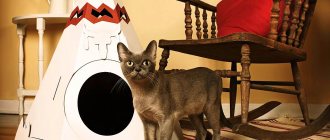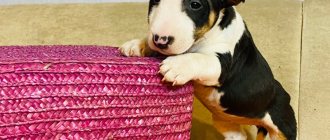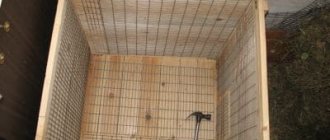A kitten in the house is always a source of joy and positivity, but it is important not to forget that the pet has its own needs. For example, a timely purchased scratching post will not only save furniture and wall coverings from sharp cat claws, but will also certainly please the kitten. In addition, do not forget that you can easily make a device from wood and strong rope yourself.
What is better for a cat, sisal or jute?
If you have a kitten or your cat uses the scratching post not very often and without much activity, then you can give preference to jute - it is softer and more pleasant in cost. If you have an adult cat (especially a large breed) or several pets, choose sisal
.
Interesting materials:
How to properly and quickly pick blueberries with a combine? How to cut glass correctly and evenly? What is the correct name for irises or irises? How to use a gasoline generator correctly? How to use vermicompost correctly? How to use double superphosphate correctly? How to use thinning scissors correctly? How to properly use phytosporin m for indoor flowers? How to properly use succinic acid for seedlings? How to use an air ionizer correctly?
Making a scratching post
As we said, online stores now have a huge range of different scratching posts: all colors and shapes. Why make a scratching post with your own hands? Let's list the main advantages of a homemade device for cat claw points:
- Saving money. A homemade structure will cost you much less than a purchased one.
- To make it, you can take everything you have or make it to match the style of your apartment interior.
- You can make a real castle with passages, steps, a two- or three-story house for your pet.
- All design elements can be adjusted to the dimensions of your pet. For example, today the most popular breed is the Maine Coon. These are quite large cats that will require a slightly different size house with a scratching post.
For a simple kitty, you only need two parts: rope/rope and a post.
Floor-standing
Perhaps the simplest designs to implement. They can be of various shapes and located on the floor or at an angle to it. In addition, they can be combined with some other elements, columns, houses.
How to make a floor scratching post
We suggest making a floor scratching post from corrugated cardboard yourself with step-by-step instructions. To work you will need:
- construction tape,
- pencil,
- ruler,
- scissors or wallpaper knife,
- glue.
You can take a box with low sides for the mold, but you can do without it by securing the finished structure with cardboard tape around the perimeter.
Necessary tools for making a scratching post
Place the strips tightly in the box
Cut the cardboard into strips to fit the length and height of the box. Glue the strips with glue and connect them. It is advisable to use glue with a minimally noticeable odor, for example, PVA. After drying, the nail clipper is ready for use.
Simple round corrugated cardboard scratching post
Corrugated cardboard bends quite easily, so the second version of the scratching post is a twisted long strip secured with glue or adhesive tape. In this case, the size can be chosen at your discretion, and in case of long-term use, simply add layers as the shaggy consumer grows.
Which rope is better to choose?
The choice of ropes is very large, but the main thing you need to pay attention to when choosing is natural fibers. Environmentally friendly materials of natural origin are the best ropes for scratching posts; they are completely safe for both animals and people, are not electrified and will not harm the pet. A cat will definitely like a scratching post coated with natural fiber, which cannot be said about a purchased one made from artificial rope. Some pets may be put off by the synthetic smell, as well as the presence of paint and impregnation.
Polypropylene and nylon ropes are several times stronger than natural ones, but they tend to stretch, and cat's claws can get tangled and stuck in the fibers of the material.
A hemp rope wrap for a scratching post will not last long; the material will quickly fluff due to fragments of fibers.
Types of ropes
Today there are several types of the most common ropes:
- Cotton. The most expensive type of material, it looks beautiful and will fit into any interior.
- Sisal. Lower in cost, durable with a gray-yellow tint.
- Jute rope for scratching post. It is the most popular material for scratching posts. It is the most affordable and durable. With its help you can make designs of the most intricate shapes. It is not as rigid as the previous representative and is not inferior in strength and elasticity.
The website https://ecojute.ru/articles/kanat-dlya-kogtetochki/ presents a large assortment of jute ropes of different diameters. Choose and purchase. Delivery is carried out throughout Russia.
A simple solution to the problem of sharp claws
How to do it? In our ROPE MARKET store you can buy a rope for a scratching post and make this simple device yourself. It’s even easier to buy a ready-made scratching post or a cozy house for your pet, where he will play, sleep and sharpen his claws.
The main requirements for a scratching post are that it must be sufficiently stable and made of durable material, because the cat will jump excitedly and shake the device every time it wants to play or sharpen its claws.
How much rope do you need?
Currently, any rope product has high strength and resistance to tearing. But before starting work, you need to decide on the length of the rope. There are two measurement methods.
- Use old rope for a scratching post. This means removing the rope completely, measuring it and ordering a similar one in an online store or taking it with you to the store so that the seller can advise you on the best option.
- Calculate using the formula: Rope/rope length = (post height/rope/rope diameter) * 3.14 * post diameter.
Vertical, columnar
The accessory reminds a cat of a tree, which the animal regularly climbs in its natural environment, grinding its claws down. Assess the stability of the accessory - the device should not wobble and be similar in height and build. Otherwise, there is a risk of injury, or the cat will simply refuse to use it.
The floor structure comes in several variations:
- free-standing column with a flat, stable base;
- the accessory is complemented by a shelf;
- with gaming function;
- with unusual additions;
- The column is made in the shape of a decorative palm tree or toy figure.
Wall mounted
The most economical option and easy to implement (see photo above). Fastening is carried out to the wall in the right place, but you can simply hang it. The material may be different: wood, twine, etc.
How to make a wall-mounted claw clipper
A stronger and more durable claw scraper would be a piece of wood. Cleared of the remaining bark, sanded and wrapped in places with thick twine, the tree will turn into a necessary item for the animal. It should be taken into account that the wood is quite hard and not all cats will like it as a “sharpener”.
To make your own wall scratching post you will need:
- plywood or board 20 cm wide and 50 - 60 cm long;
- rope or fabric;
- glue, stapler;
- glue gun or just glue;
- screwdriver
You can make the board yourself or choose the right size. It is not necessary to blindly follow the sizes - the main thing is that the animal is comfortable in height and width. You can also use corrugated cardboard glued in several layers as a base. You just need to think about a strong mount to the wall. Using a screwdriver, drill a hole in the board for fastening. If you need to prevent swaying, then make two holes at the top and bottom or both at the top.
Size doesn't really matter. The main thing in a scratching post is to fulfill its direct function.
Winding the twine around the base, apply glue in some places with a gun and lay the thread on it. This is necessary to prevent the wound rope from moving. If you don’t have such a gun, you can use simple glue, applying enough of it to attach the rope.
As fabric for the scratching post, you can use drape, overcoat cloth, Chelsea cloth, as well as fur or carpet. In this case, you can secure the material from the reverse side with a stapler.
The simplest claw clippers - easy and fast
In a house where a cat has appeared, a scratching post for it becomes almost an essential item for the owners, if they do not want to subsequently admire damaged things. Because in her absence the cat will sharpen its claws on anything, most often furniture. And if she gets used to something, it will be quite problematic to wean her off later.
If a cat appeared in the house unexpectedly, or there is no time to create a stationary claw sharpener, then the simplest methods for making them are suitable for this case. The simplest scratching post can be a piece of soft wood log with peeled bark 70-100 cm long. A wooden scratching post is very strong, durable and does not require cleaning. You can cut a log in half along the grain and attach it to the wall.
A DIY cat scratching post made from packaging cardboard can be made instantly. To do this, simply roll the packaging cardboard tightly and tie it tightly in several places with twine. The height of the roll should be approximately equal to the length of the cat with its paws extended, and the width of the roll should be slightly less than the thickness of the cat. With a high degree of probability, the cat will show interest in the process and begin to scratch the cardboard without waiting for the end of production. As a result, the furniture in the house will be safe and sound.
If the cat has not shown any interest in the process, then you need to play with this roll with it after production is complete. This should be done when the cat wants to play, and not eat or sleep. Under no circumstances should you wake up a sleeping cat and try to play with him with such a roll. This is often provoked by children who are impatient to offer their pet a new game. Therefore, children need to be explained in advance that a sleepy animal can be frightened by such a large object, and after that it will avoid the cardboard roll.
If you don’t succeed in playing, then you need to lightly moisten the tip of your finger with tincture of valerian and touch it to the roll or rub the cardboard a little with catnip. From an old carpet or carpet with a fabric backing, you can make an excellent nail clipper in a matter of minutes. To do this, you need to roll the carpet with the wrong side out and tie it with twine in several places. Cats love this type of scratcher regardless of its size and get used to it instantly - just show it once. It lasts a long time and is suitable even for large active cats.
A wonderful DIY cat scratching post can be easily made from an ordinary bag made of natural material. In the bag you need to put an old unnecessary item made of natural fabric, rolled into a tube, or a strip of cardboard 7-10 cm wide. And then roll the bag tightly. Secure the edge of the bundle with twine, threading its pieces into the burlap and tying them with a knot. The distances between the burlap threads are large, and threading twine through them will not be difficult. For convenience, you can use a crochet hook, if you have one.
A voluminous roll of burlap, inside of which there is a folded item, can be stylized as candy by tying it with twine at a short distance from the edges. You can also stylize it as a sausage by tying it with a rope at equal distances along its entire length, just as sausages are tied up. On a flat claw board you can draw a fish or a cat’s face with a marker or felt-tip pens, and it will look much more interesting. And a small kitten can use such scratching posts made of burlap for quite a long time.
It is imperative to pay attention to materials that are suitable for their manufacture and safe for cat health.
How to calculate the length of a rope for a scratching post?
The length of the fiber directly depends on the height of the column. If it is 1 m with a cross-section of 11 cm, then the length of one turn will be 35 cm. By making a simple calculation, you can find out that the total length of the rope must be at least 35 m.
Although some animals have lived alongside humans for a long time, they are not devoid of their natural instincts. Properly chosen furniture for your pet will help avoid damaged furniture and torn wallpaper. Therefore, hurry up to make a house or scratching post for your pet. By making furniture for your pet with your own hands, you will not only save money, but also create a unique product that will suit your pet specifically.
What materials are used to make a DIY scratching post?
You don't need too many materials to make the product, most of which you can find at home or in the garage. Carry out an audit to find the necessary material for a homemade scratching post for cats:
- A piece of board, timber, plastic pipe - anything that can play the role of a trunk.
- Any covering or rope that is convenient for sharpening claws.
- A couple of planks to build shelves.
- A little fabric, for example, an old flannel blanket, is quite suitable for a bed.
Note! If the DIY procedure seems complicated to you, there is a simple alternative - bring a small stump with bark into the house. Pussy will be satisfied.
Jute twisted rope
Jute is a fiber from the linden family. Jute threads are used in the textile and non-textile industries. They are used to produce paper, shoes, clothes, and bags. Jute is also used to make burlap and rope, as well as furniture fabric. It is hygroscopic, that is, it is able to absorb moisture, but does not let it in. Jute twines are inferior in reliability to sisal and hemp, and therefore are used mainly for interior design. Features of jute:
- you can buy cheaper than sisal;
- darker in color;
- less durable with active use.











